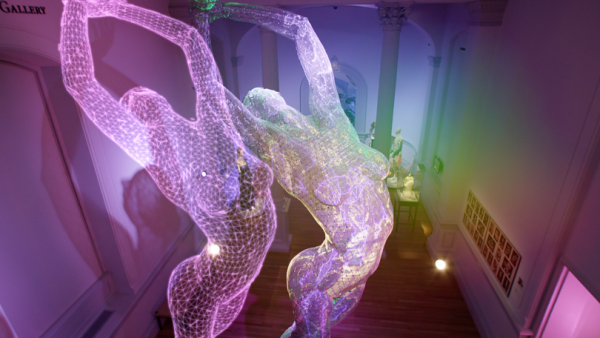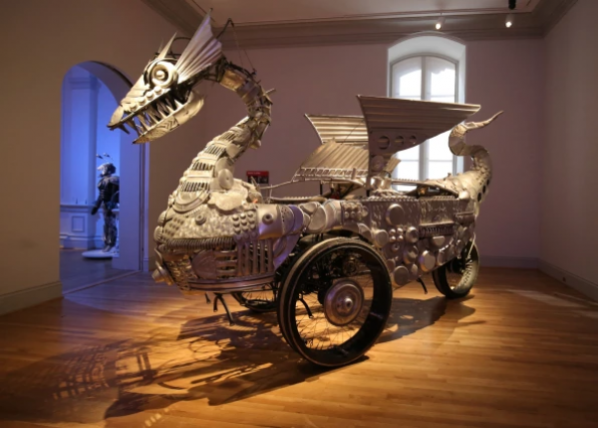Smithsonian Renders Art Exhibition in Virtual Reality
The iconic Smithsonian American Art Museum (SAAM) has partnered with Intel and Second Life creator Linden Lab to render its current art exhibition No Spectators, The Art of Burning Man in virtual reality. The project is powered by Intel technology and is rendered via Linden Lab’s social VR platform known as Sansar.

SAAM is not the first museum to embrace virtual art. In the recent years, artists and curators have been embracing the new medium to create virtual reality art experiences. In 2017, the Guggenheim Museum also entered into a partnership with the Google Cultural Institute to offer users a VR experience of the museum and its art work. The British Museum has also been onto cutting edge VR art exhibitions. It transformed its Ancient Egyptian collection into an interactive 360 experience.
If you have a VR headset, you can take a virtual reality tour of Smithsonian’s No Spectators exhibition either alone or with the Smithsonian virtual tour guides. It offers an incredible simulation of the exhibition including the room-sized installations, costumes, ephemera and the jewelry.
Smithsonian partnered with Intel on this project in order to make the art museum’s exhibitions more accessible to the general populace, including those that cannot access the museum for one reason or another or those who want to store the exhibition in digital format for future viewing.
The virtual reality rendering is completely immersive and unique. Various elements come together nicely to create a mind-blowing experience. It is something that you have never experienced before. The social aspect of Sansar makes for a very interactive virtual reality art exhibition experience. Irrespective of their location, users can log onto the platform and get virtual tours from the exhibition’s curator in real time.
While Linden Lab lent its social VR platform for the creation of this virtual reality experience, Intel provided its powerful computers to process the data sets for the project. The use of photogrammetry cameras as well as LIDAR scanners provided for very rich imaging data that proved quite effective for the final virtual reality rendering of the exhibition.
How the Smithsonian Art Exhibition Virtual Reality Experience was Created
There were two main tasks involved in rendering the exhibition in virtual reality. The first entailed the recreation of Smithsonian’s Renwick Gallery and the second one was the simulation of the art works. The building was re-constructed in virtual reality using its original floor plan although Linden Lab also relied on spatial laser capture data to accomplish this task.
In the simulation of the artworks, Linden Lab made use of two 3D capture studios, Insight Digital and xRez for the initial captures of the art pieces that were displayed on the gallery. For one particular artwork, the Tin Pan Dragon by Dwayne Flatmo, Linden Lab captured some 3000 images which created data mesh with close to 1 billion polygons. Linden Lab then used these polygons and various gigabytes of texture data and truncated it to a mesh of 150,000 polygons and at least one texture map.

The challenge for Linden Lab was about capturing all the myriad pieces and presenting all the details and intricacies while preserving their intent so as not to lose the “compelling” aspect of the artwork. Linden Labs achieved this at 180 frames-per-second which is the ideal frame rate for a good quality virtual reality rendering. For each of the art pieces to work in virtual reality, Linden Labs had to realize a 99.9% reduction in their total data footprints.
At the moment, only the first floor of the art exhibition is available in Sansar though the artworks that are on the second floor are expected to be availed in virtual reality by late September. However, the VR art experience will not end with No Spectator. The Smithsonian American Art Museum plans to collaborate with Intel and Linden Labs over the long term on virtual reality renderings in its future exhibitions and collections.
https://virtualrealitytimes.com/2018/08/04/smithsonian-renders-art-exhibition-in-virtual-reality/https://virtualrealitytimes.com/wp-content/uploads/2018/08/The-Art-of-Burning-Man-at-Smithonian-Art-Museum-600x314.pnghttps://virtualrealitytimes.com/wp-content/uploads/2018/08/The-Art-of-Burning-Man-at-Smithonian-Art-Museum-150x90.pngArtTechnologyThe iconic Smithsonian American Art Museum (SAAM) has partnered with Intel and Second Life creator Linden Lab to render its current art exhibition No Spectators, The Art of Burning Man in virtual reality. The project is powered by Intel technology and is rendered via Linden Lab’s social VR platform...Sam OchanjiSam Ochanji[email protected]EditorVirtual Reality Times - Metaverse & VR
